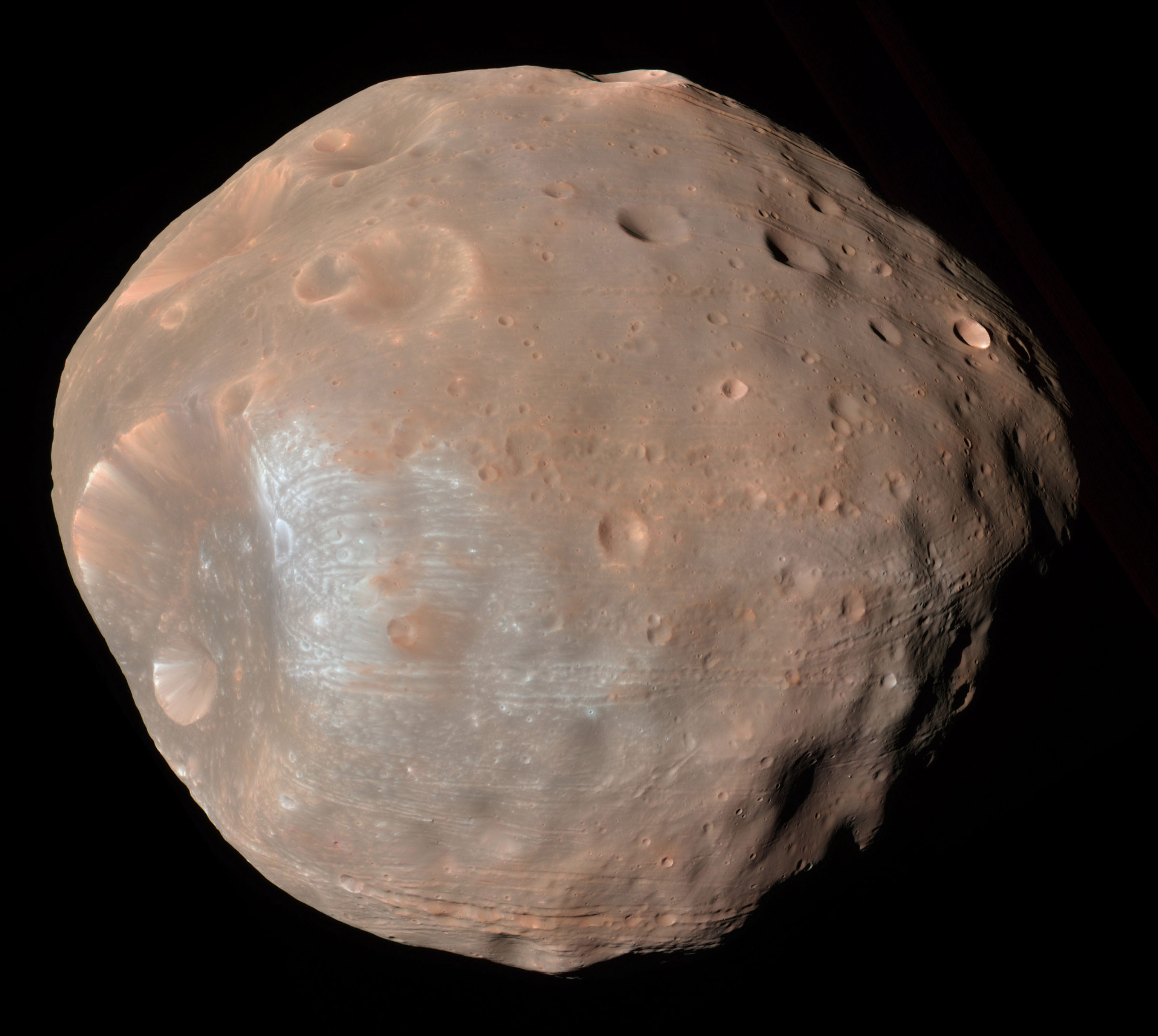MMX, Japan’s Martian Moons eXploration mission
Highlights
- Where did the Martian moons Phobos and Deimos come from? The answer will help us understand what the inner solar system was like shortly before life arose on Earth.
- Japan’s Martian Moons eXploration mission, or MMX, launches in 2026 to study the moons and return samples from Phobos to Earth in 2031.
- One of MMX’s two sample collection devices is PlanetVac, a technology Planetary Society supporters helped enable by funding tests in 2013 and 2018.
Why do we need MMX?
There’s a lot we don’t know about the Martian moons Phobos and Deimos. They are small and lumpy, with Phobos measuring just 22 kilometers (14 miles) across and Deimos even more compact at 13 kilometers (8 miles) wide.
While it’s possible Phobos and Deimos are asteroids captured by Mars’ gravity, their circular orbits suggest they formed from debris knocked into space from Mars itself. In our solar system’s early days, asteroids and comets bombarded the inner planets, possibly bringing to Earth water and organics—two key ingredients for life. Mars may have been similarly impacted, with the resulting orbital debris becoming rings that clumped into small moons. It’s possible Mars’ gravity tore the innermost moon into rings again, and that Phobos is a product of an ongoing ring-moon cycle!
Figuring out how Phobos and Deimos formed would give scientists another data point in determining what happened in the inner solar system before life arose on Earth. Japan’s Martian Moons eXploration mission, or MMX, will survey the moons and bring a sample of Phobos back to Earth. If the moons came from a giant impact on Mars, the resulting heat and energy should have removed most traces of water. If the moons are captured asteroids, they should have substantial water and organic materials like we find on similar small worlds.
MMX is also a technology demonstration mission. Phobos will be one of the farthest worlds we’ve collected samples from, and MMX will have to travel deep within Mars’ gravitational influence to collect them. Phobos itself has just enough gravity to require careful maneuvering to keep MMX from landing too hard, but not enough gravity to keep the spacecraft from bouncing if it doesn’t absorb the impact properly.
Studying Phobos using MMX’s remote sensing instruments will tell us a lot, and the samples it returns to Earth will tell us even more. Despite impressive technology advances for robotic space missions, certain science questions can only be answered by tools that are too large, heavy, and power-hungry to fly on spacecraft. Furthermore, the samples are likely to contain diverse bits and pieces of Mars from across the planet, thrown into orbit by meteorites.


How will MMX study the martian moons?
MMX will launch in 2026 and enter Mars orbit a year later. It will gradually get closer to Phobos, entering what mission planners call a quasi-orbit: while it may look like MMX is orbiting Phobos, it is actually just orbiting Mars in a way that lets it circle Phobos at the same time. This will be no easy challenge, since Phobos is deep inside Mars’ gravity well and just 6,000 kilometers above the surface (Earth’s Moon is more than 60 times further away).
MMX will spend a year studying Phobos with its remote science instruments while searching for a safe and scientifically interesting place to land. A wide-angle camera and laser mapping system will map the moon in 3D, while a narrow-angle camera provides a closer look at specific areas. Three spectrometers, two of which are international contributions from the French space agency CNES and NASA, will determine the mineral and elemental makeup of Phobos’ surface. A dust sensor will also look for orbiting particles knocked off Mars and Phobos by meteor impacts. The spacecraft also includes a pair of ultra-high-resolution video cameras from the Japanese Broadcasting Corporation that will provide stunning views of Mars and its moons. Some images will be transmitted to Earth during the mission, with the rest stored in the sample return capsule for later playback.
As MMX descends to Phobos for landing, it will deploy a small German and French-built rover based on the MASCOT, which Hayabusa2 dropped to tumble around asteroid Ryugu. The rover will travel around Phobos for at least 100 days analyzing the surface.
We don’t know exactly what Phobos’ surface is like: is it rocky, fluffy, or sandy? MMX is prepared for a variety of possibilities with two sampling devices called C Sampler and P Sampler. C Sampler is a robotic-arm-mounted drill that can bore 10 centimeters beneath the surface. P Sampler works by releasing pressurized gas to kick up surface materials, which travel through a tube into a collection container.
P Sampler is a derivative of Honeybee Robotics’ PlanetVac, a Planetary Society-supported technology designed to simplify and lower the cost of sample collection. Our members and supporters funded PlanetVac tests in 2013 and 2018, demonstrating its readiness for use on future space missions. NASA is including the technology on a 2023 commercial Moon flight, and is contributing P Sampler to Japan for the 2026 MMX mission.
Once MMX collects its samples, it will lift off from Phobos and begin spiraling out of Martian orbit, passing Deimos several times on its way out to analyze and map the smaller moon. MMX will leave Mars in 2030 and return to Earth in 2031. The spacecraft will jettison a small capsule containing the samples, which will plummet through Earth’s atmosphere and use a parachute to land safely for collection.
Martian Moons eXploration mission overview An overview video of Japan's Martian Moons eXploration mission.
Support missions like MMX
Whether it's advocating, teaching, inspiring, or learning, you can do something for space, right now. Let's get to work.
Acknowledgements: This page was initially written by Jatan Mehta in 2020 and is regularly revised and updated by Planetary Society staff writers.


 Explore Worlds
Explore Worlds Find Life
Find Life Defend Earth
Defend Earth


